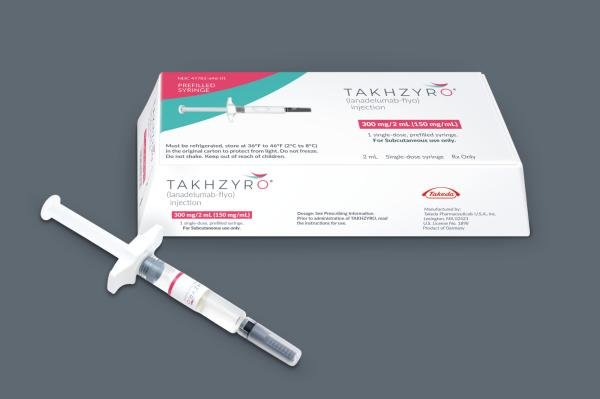Lanadelumab Side Effects
Applies to lanadelumab: subcutaneous solution.
Precautions
It is very important that your doctor check your or your child's progress at regular visits to make sure that the medicine is working properly and to check for unwanted effects.
Make sure to use this medicine regularly. HAE attacks are life-threatening and require immediate medical attention. Carefully follow all of your doctor's instructions.
This medicine may cause serious allergic reactions, which can be life-threatening and require immediate medical attention. Call your doctor or nurse right away if you or your child have a rash, itching, hives, hoarseness, chest tightness, lightheadedness, dizziness or fainting, trouble breathing, trouble swallowing, or any swelling of your hands, face, or mouth after using this medicine.
Make sure any doctor or dentist who treats you knows that you are using this medicine. This medicine may affect the results of certain medical tests.
Serious side effects of lanadelumab
Along with its needed effects, lanadelumab may cause some unwanted effects. Although not all of these side effects may occur, if they do occur they may need medical attention.
Check with your doctor immediately if any of the following side effects occur while taking lanadelumab:
More common side effects
- rash
Less common side effects
- chest tightness
- fast heartbeat
- fever
- hives, itching
- hoarseness
- irritation
- joint pain, stiffness, or swelling
- redness of the skin
- swelling of the eyelids, face, lips, hands, or feet
- trouble breathing or swallowing
Other side effects of lanadelumab
Some side effects of lanadelumab may occur that usually do not need medical attention. These side effects may go away during treatment as your body adjusts to the medicine. Also, your health care professional may be able to tell you about ways to prevent or reduce some of these side effects.
Check with your health care professional if any of the following side effects continue or are bothersome or if you have any questions about them:
More common side effects
- bleeding, blistering, burning, coldness, discoloration of skin, feeling of pressure, hives, infection, inflammation, itching, lumps, numbness, pain, rash, redness, scarring, soreness, stinging, swelling, tenderness, tingling, ulceration, or warmth at the injection site
- body aches or pain
- chills
- cough
- difficulty in moving
- dizziness
- ear congestion
- headache
- loss of voice
- muscle ache, cramps, pain, or stiffness
- sneezing
- stuff or runny nose
- sore throat
- unusual tiredness or weakness
Less common side effects
See also:
For healthcare professionals
Applies to lanadelumab: subcutaneous solution.
General adverse events
The most common adverse reactions were injection site reactions, upper respiratory infection, headache, rash, myalgia, dizziness, and diarrhea.[Ref]
Respiratory
- Very common (10% or more): Upper respiratory infection (up to 44%)
- Frequency not reported: Viral upper respiratory infection[Ref]
Nervous system
- Very common (10% or more): Headache (up to 33%), dizziness (up to 10%)
- Frequency not reported: Tension headache, sinus headache[Ref]
Immunologic
- Very common (10% or more): Anti-drug antibody (ADA)-positive sample during treatment with this drug (12%)
- Common (1% to 10%): Hypersensitivity[Ref]
Musculoskeletal
- Very common (10% or more): Myalgia (up to 11%)[Ref]
Gastrointestinal
- Very common (10% or more): Diarrhea (up to 11%)[Ref]
Hepatic
- Common (1% to 10%): ALT increased, AST increased, ALT or AST greater than 8 times the upper limit of normal[Ref]
Local
- Very common (10% or more): Injection site reactions (up to 56%)
- Frequency not reported: Pain, erythema, bruising, hematoma, hemorrhage, pruritus, swelling, induration, paresthesia, warmth, edema, rash[Ref]
Dermatologic
- Very common (10% or more): Rash (up to 10%)
- Frequency not reported: Maculopapular rash, erythematous rash[Ref]
References
1. (2018) "Product Information. Takhzyro (lanadelumab)." Dyax Corporation
Frequently asked questions
- How is Takhzyro injected/administered?
- What is Takhzyro used for and how does it work?
- What type of drug is Takhzyro?
More about lanadelumab
- Check interactions
- Compare alternatives
- Reviews (5)
- Dosage information
- During pregnancy
- Drug class: hereditary angioedema agents
- Breastfeeding
- En español
Patient resources
Other brands
Professional resources
Other brands
Related treatment guides
Further information
Lanadelumab side effects can vary depending on the individual. Always consult your healthcare provider to ensure the information displayed on this page applies to your personal circumstances.
Note: Medication side effects may be underreported. If you are experiencing side effects that are not listed, submit a report to the FDA by following this guide.

